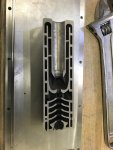Join the Hide community
Get access to live stream, lessons, the post exchange, and chat with other snipers.
Register
Download Gravity Ballistics
Get help to accurately calculate and scope your sniper rifle using real shooting data.

Install the app
How to install the app on iOS
Follow along with the video below to see how to install our site as a web app on your home screen.
Note: This feature may not be available in some browsers.
You are using an out of date browser. It may not display this or other websites correctly.
You should upgrade or use an alternative browser.
You should upgrade or use an alternative browser.
Suppressors 3D Printed Suppressors
- Thread starter jjones88
- Start date
Interesting,. Like they had said there aerospace and aviation industry has been the front runners in the additive manufacturing processes. The ability to 3D print complex components that can't be done otherwise. Many of the printed turbine components that I have seen are subjected to heat or pressure, but I can't say I have seen any that are subjected to both, especially the potential level of pressure a supressor experiences. As they said that there complex design can't be achieved with traditional methods, I wonder how it will clean up. Or is it like some of the other sealed designs where once it reaches a level of buildup that can't be flushed it's time for a new one. I'm interested, they may have an advantage with the additive manufacturing.
Made of 718 Inconel. A "super alloy" that is supposedly harder than titanium.
Inconel
https://en.wikipedia.org/wiki/Inconel#cite_note-4From Wikipedia, the free encyclopedia
Inconel 718 round bar
Inconel is a family of austenitic nickel-chromium-based superalloys.[1]
Inconel alloys are oxidation-corrosion-resistant materials well suited for service in extreme environments subjected to pressure and heat. When heated, Inconel forms a thick, stable, passivating oxide layer protecting the surface from further attack. Inconel retains strength over a wide temperature range, attractive for high temperature applications where aluminum and steel would succumb to creep as a result of thermally induced crystal vacancies. Inconel’s high temperature strength is developed by solid solution strengthening or precipitation hardening, depending on the alloy.[2][3]
Inconel alloys are typically used in high temperature applications. Common trade names for Inconel Alloy 625 include: Inconel 625, Chronin 625, Altemp 625, Haynes 625, Nickelvac 625 and Nicrofer 6020.[4]
Yeah Inconel 718 is great stuff. We use tons of it at work, takes heat and pressure excellent, very little corrosion stress cracking issues, awesome stuff. What I wonder about is how it's going to behave in that environment as a additive manufactured component. Obviously if there willing to stick there neck out on it there is something there. Seems like there in the aviation industry and working to branch out. The laser sintered metal printers are HIGH dollar. Many of which you still can't own, you have to lease them from the manufacturer.
Daniel Defense is now making a 3D printed can. Supposed to be pretty good, not sure how it compares to its competition though.
I shot an NRL match with the Kelbly team and most of them ran a 3d printed suppressor (a stubby fat one). They worked fine over 2 days of shooting and I was pretty impressed with the level of suppression given its size. Not sure what connections they may have with the company but they had nothing but good to say about them. Personally id want to see how they do a bit longer before i invested the money and 6+months of time waiting to see if it was a waste.
Nice it's a over the barrel design. I have an ultrasonic cleaner, i would think the texture of printed components would aid in more turbulent flow and friction, but buildup was my concern there. I may look further into one later this year. I have been dragging my feet on more cans in the hope that they would come off the NFA list.
We will have them at the Big 3 East media event so reviews are forthcoming. Additionally we will be running a promotion to coincide with the even so send me a PM for the promotion code.
We will have them at the Big 3 East media event so reviews are forthcoming. Additionally we will be running a promotion to coincide with the even so send me a PM for the promotion code.
R u guys going to make more in different calibers? Pistols?
I'm sure this will play fovorably, but it's still to early to tell how cost effective it can be.
http://www.sciencemag.org/news/2017/10/3d-printing-doubles-strength-stainless-steel
http://www.sciencemag.org/news/2017/10/3d-printing-doubles-strength-stainless-steel
R u guys going to make more in different calibers? Pistols?
We will be expanding our offering throughout the year, and yes we are working on a pistol suppressor. Our next product release will be shown off at both the Big 3 East media event and the 9th Annual USASOC Sniper Competition.
I'm sure this will play fovorably, but it's still to early to tell how cost effective it can be.
http://www.sciencemag.org/news/2017/10/3d-printing-doubles-strength-stainless-steel
Given the complexity of some of our designs, additive manufacturing is the only cost effective method for manufacturing. Another benefit is the wide variety of materials which can be used that are not readily available for traditional manufacturing techniques.
Similar threads
- Replies
- 8
- Views
- 641
Precision Rifle Gear
Where's the thread about 3d printed brass catchers???
- Replies
- 3
- Views
- 247
Precision Rifle Gear
Pfl338 3d printing goods
- Replies
- 7
- Views
- 330



